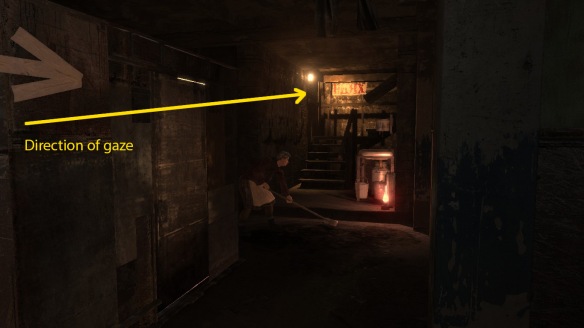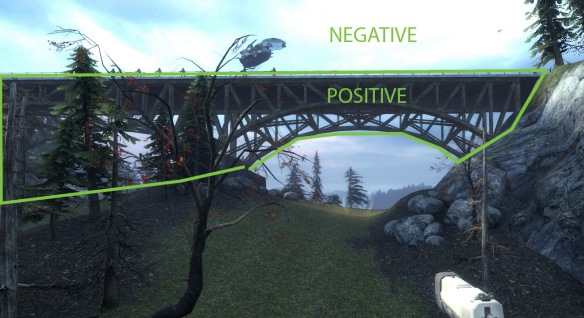Compositional techniques have always played a fundamental part in constructing aesthetically pleasing imagery throughout art history, specifically referencing the placement and organisation of visual elements. Established as a vocabulary for artists, the theories used were focused on achieving unity within these visual elements and guiding the viewer’s eye through them.
After investigating compositional theories in a broad sense, it soon becomes apparent that they can indeed be applied to various areas of a game’s design and visual identity. Some are purely in regards to aesthetics, such as a visually pleasing yet functional layout of UI elements. However they are also very much embedded inside the mechanics and systems of the game. An example would include using compositional values to achieve a harmonous balance of enemies to engage with, or within the array of weapons available during the conflict. Considering single player level design, for this post I want to specifically focus on how we might take some traditional compositional theories and try to adapt and apply them to help influence player direction through the game space.
CORE COMPOSITIONAL VALUES APPLIED TO LEVEL DESIGN:
The most important idea that we can take from these compositional theories is the focus on guiding the viewer’s eye through elements of an image. Traditionally, composition has been applied to static imagery, with the frame of reference being dictated by the artist. However, as designers working with a player-controlled camera, there are no guarantees that the player will be looking where we want them to, when we want them to. Therefore we can investigate into how certain compositional theories might be adapted to influence the player’s eye towards the areas we want them to look at or go towards. In single player level design, I believe that intelligent application of composition can help to guide and constrain the player through an optimized narrative path that the designer has crafted.
Vertical lines:

Vertical lines tend to represent power, stability and strength, exaggerating the impression of height and grandeur in architecture. This example from Dishonored evidences this, presenting an oppressive, intimidating ‘building’ that the player needs to infiltrate.
Horizontal Lines:

Horizontal lines imply a sense of calm and tranquility. In level design these can be implemented most effectively in moments of exploration where the player is in little danger, such as this scene from Mirror’s Edge where the player is navigating through a confined, yet safe space inside a building.
Directional lines/architectural elements:
The arrangement and position of architectural elements can lead the player’s eye along, directing movement as well as attention. The flow of interconnected spaces is enhanced by these directional elements, using physical world properties to effectively lead the player where the designer wants them to go.
Lighting:

Effective use of lighting can be used to direct the player’s attention towards a certain location within the space. As this screenshot from Metro 2033 evidences, singular spotlights are often used in darker environments to guide the player’s eye towards an area of interest. In this case, the light reinforces the door as the most important object in the current scene, heightening the expectation of what may lie behind it.

Sometimes lighting can be used in conjunction with other leading architectural elements. In this slightly less subtle example, the arrow taped onto the left wall directs the player’s gaze across and towards the light at the back of the corridor, effectively informing the player to continue down this path towards and up the stairs.
Framing:

Framing is traditionally used in composition to crop and frame an area of interest within the field of view. In the same way that we can direct the player’s gaze through lines and lighting, we can also manipulate their field of view through level geometry and scripted events to guide the player’s eye to a specific area of interest. However in my opinion the scripted event should never involve taking control of the player’s camera away from them, they are just another technique that can be used within the game space to draw the player’s attention. In this Half Life 2: Episode 2 example, the player emerges from an underground mine tunnel to the surface outside. The first thing the player sees is the large combine presence crossing the bridge in the distance. Framed by the doorway and further emphasized by the sloped entry, it is almost impossible for the player not to witness the framed story event in the distance.
Positive/Negative space:

Shapes are created by both the physical geometry that occupies the space and the emptiness that surrounds it. This creates positive/negative spatial elements, providing architecture that can be interesting both aesthetically and in terms of how the player engages with it.

Effective implementation of positive/negative geometry can be reinforced by using strong silhouettes. This aids the readability of a structure, both in introducing new memorable structures to the player and then making them recognizable when they come across them again at a later time.
Repetitive elements/rhythm:

Repetition of visual elements can sometimes have a calming effect on the player, as the eye is naturally drawn along patterns. Disrupting these rhythmic elements can have the opposite effect on the player, creating unease and placing an emphasis on the isolated area.
Scale:

A sense of scale is created by the relationship between shapes within the space, as using one object as a size reference for another aids the player’s understanding of scale within the scene. Typically this can be used to emphasize the large or small size of something when it is placed against its opposite. In this example from Halo 4, it translates to vehicles as well as architecture. Having the smaller vehicle next to the larger one further emphasizes the distinct difference between the two, the latter object’s scale communicated more clearly to the player through this specified placement of items.
It soon becomes apparent that clever application of compositional techniques in level design can be incredibly important in directing the player and communicating information, as well as maintaining visual balance and rhythm within the space. One major benefit I feel strongly about is that it removes the emphasis from scripted moments that take control away from the player, such as cut-scenes and quick time events. Clever use of composition focuses on communicating information through the environment, utilizing carefully placed elements within the space to influence meaningful player decisions. The player controlled camera seemingly causes a natural conflict with traditional composition techniques based on static images, however further investigation shows that they can be implemented to provide an interesting relationship between the designer, player and the game space, providing experiences unique to the medium.

2 replies on “Composition techniques and player direction”
Fantastic Post, I’ll be pointing people in this direction, very interesting.
[…] Shape of Play: “Composition Techniques and Player Direction” COMPOSITION TECHNIQUES AND PLAYER DIRECTION […]